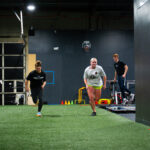Speed Training Techniques for Explosive Athletes
Speed training is essential for athletes who want to boost performance. Whether you’re on the track, field, or court, improving speed gives you an edge. This guide explores proven speed training techniques that enhance quickness, explosiveness, and agility.
Let’s dive into how you can train smarter and become faster.
Why Speed Training Matters
Speed training improves acceleration, top speed, and movement efficiency. It sharpens reaction time and increases force production. These skills are crucial in sports like football, soccer, basketball, and track and field.
Moreover, faster athletes often have a psychological advantage. They dominate plays and create more opportunities for success.
Key Components of Speed Training
Speed training involves more than just running fast. It includes targeted drills, strength training, and technique work. Here are the main areas to focus on:
Sprint Mechanics
Proper sprinting technique is the foundation of speed. Efficient arm swing, body posture, and stride length all matter. Drills like A-skips, B-skips, and wall drives reinforce these mechanics.
Acceleration Drills
Acceleration is the ability to reach top speed quickly. Use resisted sprints, sled pushes, and short hill runs to build this skill. Start with short bursts of 10–20 yards and progress as you improve.
Plyometric Training
Explosiveness begins with power. Plyometric exercises such as box jumps, bounding, and depth jumps develop fast-twitch muscle fibers. Always warm up before jumping drills to prevent injury.
Strength Training for Speed Gains
Speed and strength go hand in hand. Building a strong lower body helps with force production and stride power. Focus on compound lifts like squats, deadlifts, and lunges.
Use proper form and train both bilateral and unilateral movements. Don’t ignore the posterior chain—hamstrings and glutes play a major role in sprinting speed.
Speed Training Drills You Can Start Today
Here are a few beginner-to-intermediate drills that improve speed training outcomes:
-
High Knees: Focus on knee drive and foot turnover. Perform for 3 sets of 20 seconds.
-
Sled Pushes: Use moderate resistance. Push for 10–20 yards. Rest and repeat 4–6 times.
-
Bounding: Long, exaggerated strides enhance stride power. Perform for 30 meters, 3 rounds.
-
Wall Drills: Hold a sprinting position against a wall and drive knees rapidly for 10–15 seconds.
These drills reinforce proper mechanics and build the neuromuscular foundation needed for speed.
Common Mistakes in Speed Training
To make the most of your training, avoid these errors:
-
Skipping warm-ups. Always prep your body with dynamic movements.
-
Ignoring rest. Your body needs recovery to grow stronger.
-
Using bad form. Poor mechanics lead to slower times and increased injury risk.
-
Training without a plan. Structure your workouts to track progress and avoid burnout.
Always prioritize quality over quantity during speed training.
Combining Speed with Agility
Speed is one piece of athletic movement. Agility helps you change direction quickly while maintaining balance. Combine speed training with cone drills, ladder drills, and reaction exercises to develop all-around quickness.
Training both speed and agility creates more complete athletes.
Tracking Progress and Staying Motivated
To stay consistent, track your sprint times and drill improvements. Video yourself during training to analyze technique. Celebrate small wins, and adjust your plan as needed.
Working with a coach or joining a structured program like Next Level Athletics USA can offer professional guidance and accountability.
Conclusion: Train Smart to Get Fast
Speed training takes commitment, structure, and smart execution. Focus on technique, build strength, and stay consistent. Whether you’re new to the game or a seasoned athlete, speed gains are within reach.
By applying the right drills and mindset, you’ll see noticeable improvements in your performance.
Start today—and sprint toward your athletic goals.


Recent Comments